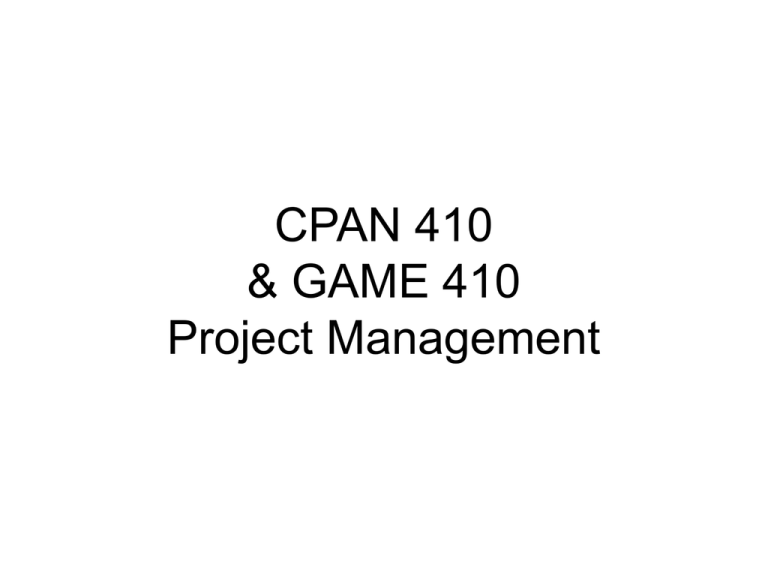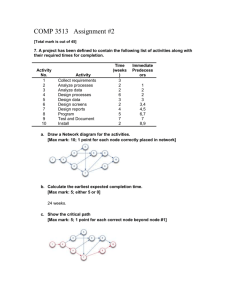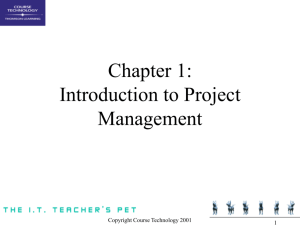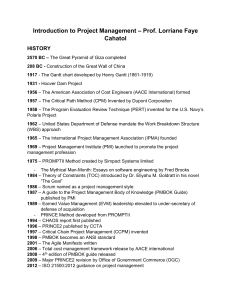CPAN 410 & GAME 410 Project Management
advertisement

CPAN 410 & GAME 410 Project Management Nicoleta Zouri Email: nicoleta.zouri@humber.ca 1. Assignments 2. Case studies/Quizzes 3. Midterm Exam 4. Final Project – teams Note: must obtain 60 or more in the midterm exam and final project for the assignments and case study to count. Passing grade for course is 60. -Explaining the difference between projects and nonprojects -Understanding the characteristics of a project - Understanding the reasons for both failure and project success - Explain the difference between an IS project and a non-IS project - Define Key terms in project management - Describe tools and technique used in project management - Understand the history of project management Project: a planned undertaking of related activities to reach an objective that has a beginning and an end Project Management Institute (PMI): an association designed to bring together project management professionals and systematically capture project management knowledge. As of 2006 it has a membership of 214,000 people from 159 countries. PMI delivers educational services and offers certification as a Project Management Professional for those with extensive project management experience. PMI publishes 3 periodicals: PMI Network, Project Management Journal and PM Today. www.pmi.org Stakeholder: a person who has interest in a new or existing project Project Sponsor: a member of the organization who is responsible for the high level support of the project Project Manager: a person with a diverse set of skills – general management, leadership, technical, conflict management, and customer relationship management – who is responsible for initiating, planning, executing, controlling and monitoring and closing down a project. Why Undertake a Project? - To take advantage of a business opportunity - To solve a business problem Project failures: • About 40% of al IT projects fail to meet business requirements • The average cancelled IT project is scheduled to last 27 weeks and is canceled on week 14. AT least $1 million spend on work without successful business outcome • The average IT organization ties up 10 % of its IT staff on work that contributes no value to the business • Project team members are usually aware 6 weeks of project failure before its finally cancelled by management Project Failure (French Study) Examples of Project failures: – Projects that finish over budget – Not completed on time – Projects finished on time and on budget but failed to deliver a system that met stakeholders expectations Top Five Causes of Project Failure (OASIG Study) 1. Lack of attention to human and organizational factors 2. Poor project management 3. Poor articulation of user requirements 4. Inadequate attention to business needs and goals 5. Failure to involve users appropriately 2004 Study by Wallace & Keil 1. 2. Lack of executive support Lack of user involvement 3. Inexperienced project manager 4. Inexperienced team members 5. Unclear business objectives 6. Unreliable estimates 7. Lack of effective project management methodology 8. New software infrastructure 9. Unstable organizational environment 10. Unreliable outside suppliers Most causes are of social and organizational issues. Failure to correctly estimate costs, duration or complexity of the project. Incorrect estimation of different aspects of project during any phase can result in failure Unique Feature of IS projects (7 unique feature for IS projects): – – – – Technological context is in continuous flux Difficulty in hiring and retaining experienced IT project employee Management of extensive user involvement necessary in IT projects. Need to understand established systems development methodologies and how these can be integrated into a project management framework. – The attempted solution may never been tried before ( build a system with a new functionality) – Managing Project Scope: the scope is likely to change in many projects – Technologies might change during the course of the project (a new version of the system might be released; company might adopt new version or move to a new technology) IS Project Complexities Project Management • The application of knowledge, skills, tools and techniques to project activities to meet project requirements. Project Management Process Groups: Initiating, Planning, Executing, Controlling and Closing a Project. Project Management Life Cycle: The phases a project goes through from concept to completition. Project Management Life Cycle • Initiate – potential projects are identified and evaluated in terms of importance to the organization • Plan – scope, time, cost and risk management planning takes place • Execute – project plan is followed • Control – project performance is measured against the project plan • Close – final paper work completed and sign off by all stakeholders Various Project Management Tools/Techniques • Gantt Chart – Tool that can be used to plan and track project activities • Critical Path Method (CPM) – A method used for determining the sequence of task activities that directly affect the completion of a project • Program Evaluation and Review Technique (PERT) – A technique that uses optimistic, pessimistic, and realistic time to calculate the expected time for a particular task • Microsoft Project – Most widely used project management software – http://office.microsoft.com/en-us/project/default.aspx • Application Service Provider (ASP) software – Web hosted project management software • Industry-Specific software – Software which addresses a specific industry or environment Work Breakdown Structure (WBS): a listing of the activities necessary for the completition of a project. Gantt Chart: a bar chart showing the start and end dates for the activities of the project. Gantt Chart Network diagram: a schematic display that illustrates the various tasks in a project as well as their sequential relationship. Project Management Body of Knowledge (PMBOK): A repository (warehouse/storage) of the key project management knowledge areas. Project Management 9 Core Areas of Knowledge: 1. 2. 3. 4. 5. 6. 7. 8. 9. Project Integration Management Project Scope Management Project Time Management Project Cost Management Project Quality management Project Human Resources Management Project Communication Management Project Risk Management Project Procurement Management (outsorcing) 1. Project Integration Management • • • Project plan development Project plan execution Integrated change control 2. Project Scope Management • • • • • Initiation Scope planning Scope definition Scope verification Scope change control 3. Project Time Management • • • • • Activity definition Activity sequencing Activity duration estimating Schedule development Schedule control 4. Project Cost Management • • • • Resource planning Cost estimating Cost budgeting Cost control 5. Project Quality management • • • Quality planning Quality assurance Quality control 6. Project Human Resources Management • • • Organizational planning Staff acquisition Team development 7. Project Communication Management • • • • Communication planning Information distribution Performance reporting Administrative closure 8. Project Risk Management • • • • • • Risk management planning Risk identification Quantitative risk analysis Qualitative risk analysis Risk response planning Risk monitoring and control 9. Project Procurement Management (outsorcing) • • • • • • Procurement planning Solicitation planning Solicitation Source selection Contract administration Contract closeout The History of Project management: Ancient Egypt – construction of pyramids Modern PM start as early as 1800 – railway development Henry Lawrence Gantt, mechanical engineer, developed Gantt chart, a tool used to plan and track project activities. Technology for Project Management: • 130 Web-based project management providers available • Project Management software can be industry specific such as: AbacusPM for fabricators, SYMPAQ SQL for accounting, CS/10,000 for Information Systems, Teamwork, low end software systems: Primavera, Copper 2004, high end: eFPro Manager. • The most well know software is MS Project. Industry Specific Software Questions Assignment • Read chapter # 1, & 2









